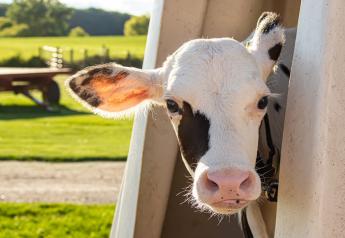Boluses of Protection

Simple treatment prevents subclinical milk fever
Well-managed herds have virtually eliminated clinical milk fever. Lurking below the surface, however, is subclinical hypocalcemia (low blood calcium), affecting a large number of second lactation and older cows.
"Nearly all second and later lactation cows experience some drop in blood calcium at calving, and about 50% have levels less than 8.5 mg/dl," says Gary Oetzel, a veterinarian with the University of Wisconsin.
|
|
Calcium is critical to fresh cows because it affects both skeletal and smooth muscle function. Lowered levels often lead to a host of problems: injury, decreased rumen function, decreased dry matter intake and increased cases of displaced abomasums and ketosis. All of which can lead to lower milk yield—up to 3% for the entire lactation.
The cost of subclinical hypocalcemia is often much larger than the clinical form of the disease. That’s because it affects so many more cows.
Oetzel says clinical milk fever in a 1,000-cow herd with a 2% incidence rate might cost $6,700 per year. But the same herd could have a 50% incidence of subclinical milk fever, costing an estimated $24,375.
"For herds with a high incidence of hypocalcemia, it may be economical to supplement all fresh cows with oral calcium," Oetzel says. For most herds, however, he recommends strategic supplementation of Jerseys, lame cows and cows with more than 105% of herd average milk production.
Oetzel applied this strategic supplementation approach on two commercial Wisconsin dairies that had just five cases of milk fever over 5,100 calvings. He dosed with a bolus containing calcium chloride and calcium sulfate at calving and again the next day. The treated cows had about 40% fewer health events than control cows and produced 6.3 lb. more milk per cow per day at first DHI test.
The form of calcium is important. "Calcium chloride has the greatest ability to support blood calcium concentrations," Oetzel says. But it’s critical to not overdose. Fifty grams of elemental form calcium chloride is plenty. More than that could result in an excessive acid load and shut down the cow’s calcium homeostatic mechanisms.
"Calcium propionate is more slowly absorbed and must be given at higher doses [usually 75 g to 125 g]," Oetzel says. Calcium carbonate, when given as an oral supplement, does not increase blood concentrations.
Oetzel has good clinical and research experience with the calcium chloride/calcium sulfate bolus (brand name Bovikalc from Boehringer Ingelheim Vetmedica, Inc.). It’s easy to administer, has no unpleasant taste, no risk of aspiration pneumonia and a prolonged release of calcium.
Oetzel recommends giving one bolus at calving and a second the next day. "The low point in blood calcium concentrations occur between 12 and 24 hours after calving," he says. "Giving only one oral calcium supplement around calving time leaves the cow without support when her blood calcium concentrations are lowest."







